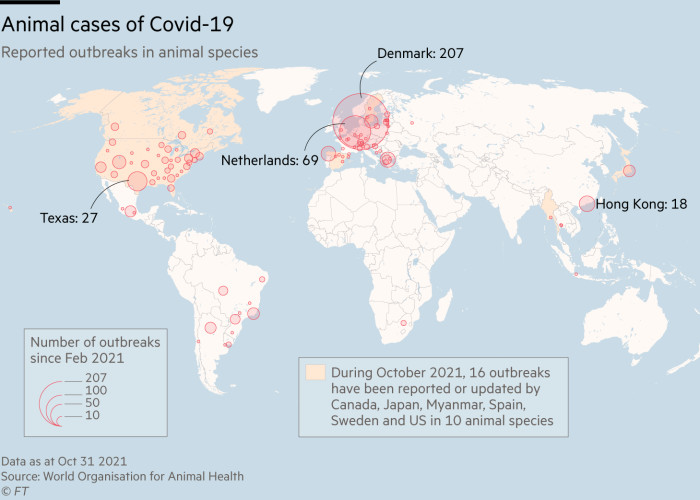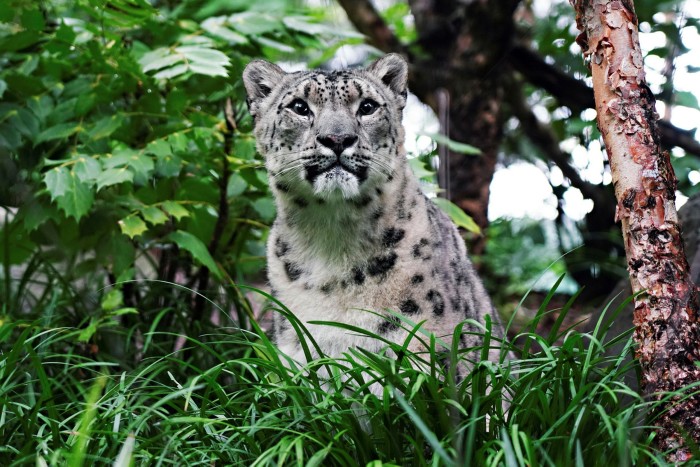www.ft.com /content/70dffb85-5c17-4dac-a1a5-b79c58d91270
Clive Cookson in London yesterday6-8 minutes 11/18/2021
Zoologists fear wildlife may become reservoir of infection that could be transmitted to people

Sign up for our post-Covid economy newsletter
Follow how business and the economy are recovering post-pandemic with our Road to Recovery bulletin. Delivered 3 times a week.
Two studies showing high levels of Covid-19 infection among wild deer in the US have renewed concerns about the virus spreading through animal populations.
The findings, released this month, come as more reports of Covid in pets and captive animals are emerging. Lincoln Children’s Zoo in Nebraska lost three rare snow leopards to the disease earlier this month.
Though the Sars-Cov-2 virus causes few or no symptoms in most non-human animals, some scientists fear that wildlife might become a reservoir of infection — and possibly viral mutation — that could be transmitted back to people. It could also threaten endangered species.
How widespread is Covid in animals?
The World Organisation for Animal Health, known as OIE, has recorded 598 Covid outbreaks in animals affecting 14 species in 30 countries up to the end of October. Almost all have involved captive animals in close contact with humans — with farmed mink in Denmark the most affected.

No one knows how prevalent Covid is in wildlife because there has been little testing. The two new studies of white-tailed deer in the US are the first to show extensive infection in wild populations.
One paper published in PNAS by scientists at the US Department of Agriculture found antibodies to Sars-Cov-2 in 40 per cent of wild white-tailed deer across four US states early this year.
A second study, led by Penn State University and not yet published, detected the virus directly through PCR testing in 80 per cent of samples taken in Iowa from the same species — the most abundant North American deer with an estimated 30m individuals.
“We were all very surprised and puzzled by the high proportion of deer testing positive,” said Katriina Willgert of Cambridge university’s Disease Dynamics Unit, who took part in the Penn State study. “The genetic and geographical data suggest multiple spillovers from infected humans and then widespread transmission onward from deer to deer.”
Which species are most susceptible to infection?
Sars-Cov-2 originated in bats and may have moved to humans via a still unidentified animal intermediary. Combined evidence from natural transmission and lab experiments suggests that the virus can infect most mammals, though unlike flu it does not infect birds.
Susceptibility varies substantially and unpredictably between species. “We are very fortunate that studies show the main farm animals — pigs, cattle and sheep — to be quite resistant to infection, unlike white-tailed deer,” said Keith Hamilton, OIE’s head of preparedness and resilience. “It would be a disaster if they were highly susceptible too.”
Cats, particularly large cat species such as lions, tigers and leopards, seem to be more susceptible than dogs, said Ken Smith, professor of pathology at the Royal Veterinary College in London.

What can people do to prevent coronavirus spreading between animals and humans?
Although the only clear evidence of coronavirus being transmitted from animals back to people came during Denmark’s intensive outbreak among mink last year, experts advise people to avoid contact with pets while they or their animals are showing Covid symptoms.
The discovery of widespread infection among deer shows that hunters should take precautions such as wearing gloves when handling carcasses, said Alastair Ward, head of biological sciences at Hull university in the UK.
Vaccines are becoming available to protect animals from Covid. Zoos in the US are inoculating a growing menagerie of species with jabs developed specifically for non-human recipients. Vulnerable big cats are a favoured target.
Zoetis, the animal health company spun out of Pfizer, has developed a vaccine based on Sars-Cov-2 spike proteins which can be adapted for a wide range of species. Farmed mink are being inoculated on a substantial scale but Covid vaccines are not generally available for pets.
Could animals be a permanent reservoir of infection — and a source of new mutations?
The US white-tailed deer studies have worried biologists. “Although experimental work suggests that the infected deer tend not to have symptoms, disease transmission in wildlife has considerable implications for human health,” said Graeme Shannon, a zoologist at Bangor University in Wales.
“The findings raise concerns that deer could be a reservoir of Sars-Cov-2. Not only could this readily infect large numbers of animals but also, more worryingly, it would spill back to humans,” he added. “Any reinfection from wildlife reservoirs could complicate our long-term efforts to fight and suppress the disease.”
A potential threat is that as the virus spreads within an animal reservoir, more dangerous strains could arise and then move into people, though that is not a foregone conclusion. Evolution that optimises fitness for another species will not necessarily make the virus more effective at infecting people. New variants emerged in mink and spread to people in November 2020, though none turned out to be unusually transmissible or virulent in human populations.
The Sars-Cov-2 variants identified within the Iowa deer were the same as those circulating at the time within the human population. But there may not have been time for the virus to evolve in these animals.
Another concern is whether Covid will disappear from the deer or continue to transmit indefinitely among them. Suresh Kuchipudi, lead author of the Penn State paper, appealed for more evidence.
“The research highlights the critical need to urgently implement surveillance programmes to monitor Sars-Cov-2 spread within the deer and other susceptible wildlife species and put into place methods to mitigate potential spillback,” he said.

No comments:
Post a Comment